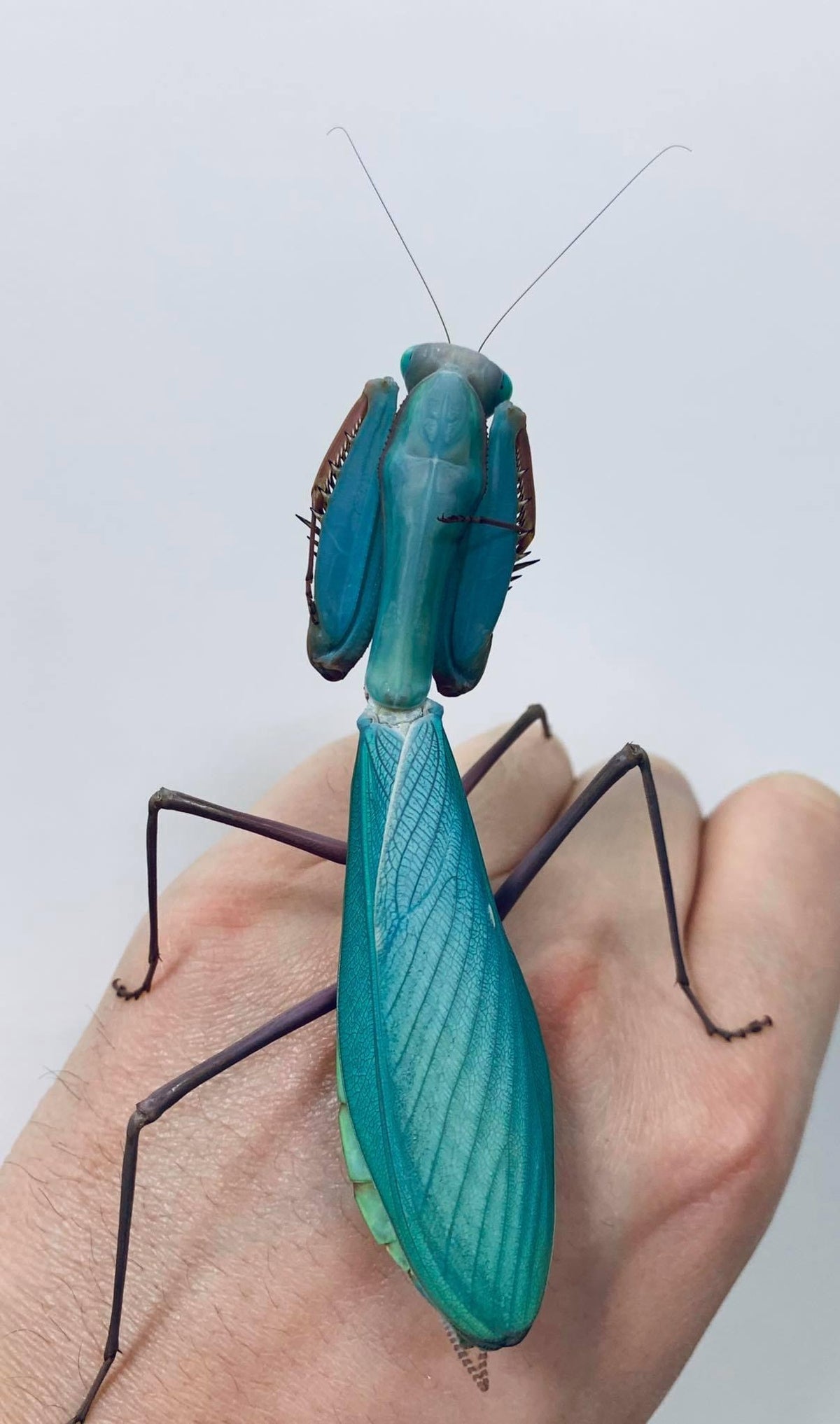















Hierodula species BLUE Papua Giant Stunning New Mantis Species
$45.00 - $65.00
Hierodula sp. Papua is large, stunningly beautiful
The Giant Papuan Mantis, or more scientifically, Hierodula species Blue Papua, is one of the largest mantis pets. Its large size and relative ease of keeping this species contribute to its popularity. Sometimes, this species is incorrectly referred to as Hierodula grandis.It will not surprise you that the Giant Papuan Mantis has its natural habitat in Asia.
The appearance of the Giant Papuan Mantis
The Giant Papuan Mantis's color is usually green/blue, but it can vary from medium green to deep blue. The beige individuals can even seem a bit pinkish. The color difference is mainly due to the environment in which the animal is kept. They can develop a different color in a matter of days, but it is not yet understood which conditions will trigger a color change.Hierodula Blue Papua is one of the largest mantis species successfully kept in captivity. Adult females are about 4.5 inches long (9 12cm), while males are 3 inches (8-9 cm) smaller. The males are also much thinner and lighter than the females. The wings of a male extend to just past the abdomen. The adult females are bigger and bulkier than the males, with wings that extend just to the abdomen. These can be larger than H venosa!
The behavior of the Giant Papuan Mantis
The hierodula species Blue Papua is a fierce kind of praying mantis. This species will actively hunt its prey once it spots it. They are not the general sit-and-wait kind of predator. A large prey insect does not scare a Giant Papuan Mantis, it will attack anything half its own body size or smaller. It won’t attack you and can be handled easily. It will not be stressed out from having its enclosure close to people or pets.An adult Hierodula species Blue Papua female
Food for the Giant Papuan Mantis
Adult Giant Papuan Mantises are no fussy eaters; they eat almost anything. When adults, they can easily grab adult crickets, adult locusts, and big cockroaches. Hierodula species Blue Papua newborn L1 nymphs eat all species of fruit fly and, when older, small crickets, flies, and young grasshoppers. They will hunt for food and are not easily intimidated by their prey.Environmental conditions and housing for this species
The ideal temperature for Hierodula species Blue Papua is about 24 ° C, but room temperature (20 ° C) will also do. At night, it can be cooler than daytime, but at least 17 ° C.This species does not have high demands concerning humidity, but it is important to spray with water every other day to allow the mantis to drink. A target air humidity is about 40 to 65%. Too high air humidity is a leading cause of death for this mantis species!
As with all species of praying mantis, this species needs a cage that is at least three times the height of the animal and at least two times the width of the animal. For an adult, this means at least 27 cm in height and 18 cm in width. A nice size for a terrarium would be 30 x 20 x 30 cm, so there is room for many fake plants and perches.
Group housing in Hierodula species No.
Because the Hierodula species Blue Papua is such an active predator, it is not recommended to house multiple individuals together. Sooner or later, only one will remain in the group enclosure. Young nymphs are not as cannibalistic as older nymphs and adults. Nymphs can be kept together in one enclosure until about L4 when fed excessively and housed spaciously.Breeding with the Giant Papuan Mantis
The Giant Papuan Mantis is a relatively easy mantis species to breed. Many people have successfully bred this species in captivity. Here is how you can do it.
First, you must ensure you have males and females of the Giant Papuan Mantis. The females of this species are much larger, heavier, and more comprehensive than the males. From around L4 nymph instar, you can spot the differences between the sexes by looking at the segments on the mantis' abdomen. Females have six segments, while males have eight. This method of sex determination can be done in an early nymph stage but can sometimes be difficult for the untrained eye. But the older the nymph becomes, the more easily the differences can be seen. Male nymphs are usually a bit smaller and will develop larger and thicker antennae than females.
A mating attempt could be made approximately 2 to 4 weeks after both partners reach adulthood. Ensure that the female ate well the days before you put the male in her terrarium (You can read the general way to mate praying mantises here). Females can be very aggressive toward males. It is recommended that the female be given large amounts of prey just before introducing the male to keep her occupied. If you see the female behave aggressively towards the male, it is better to remove the male and try another day. Giant Papuan Mantis females are relatively often cannibalistic.
Mating can take several hours. If you want the male to live, he must be removed from the enclosure as soon as mating ends.
The female will produce around 5 to 8 ootheca. From each of these oothecae, around 200 nymphs can hatch! The nymphs are small and brown–greenish and will start to eat fruitflies after a few hours to one day. Take care of the ootheca roughly the same as you take care of the species.















